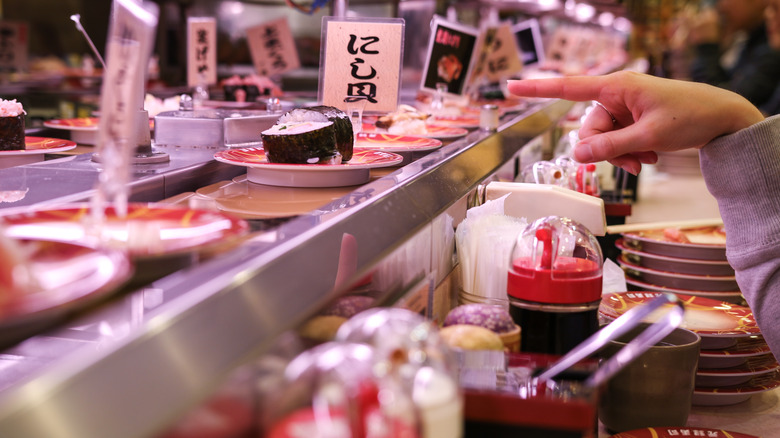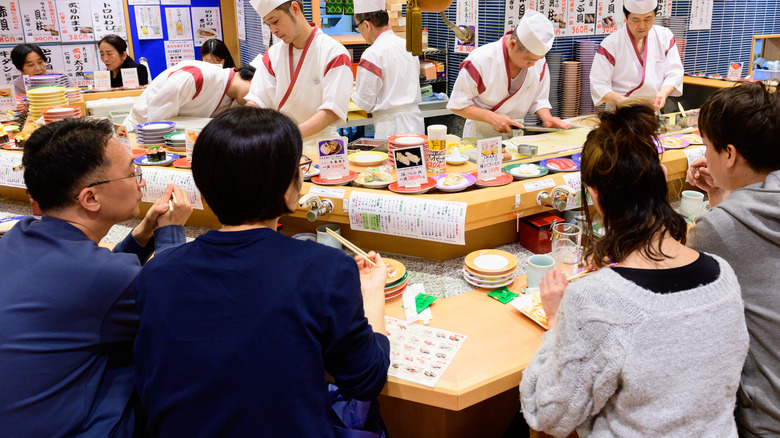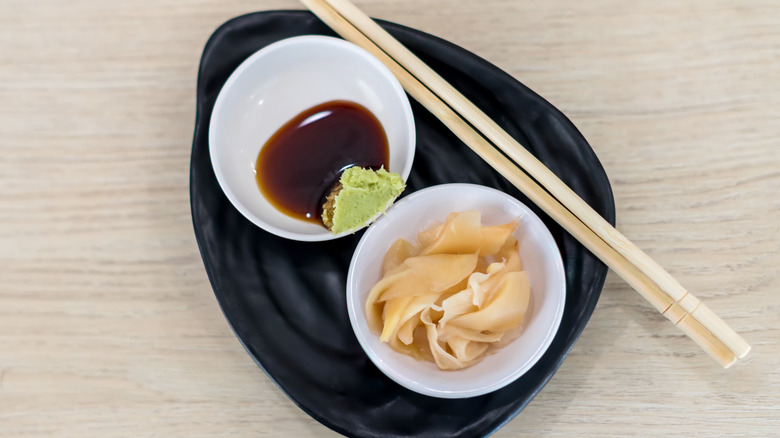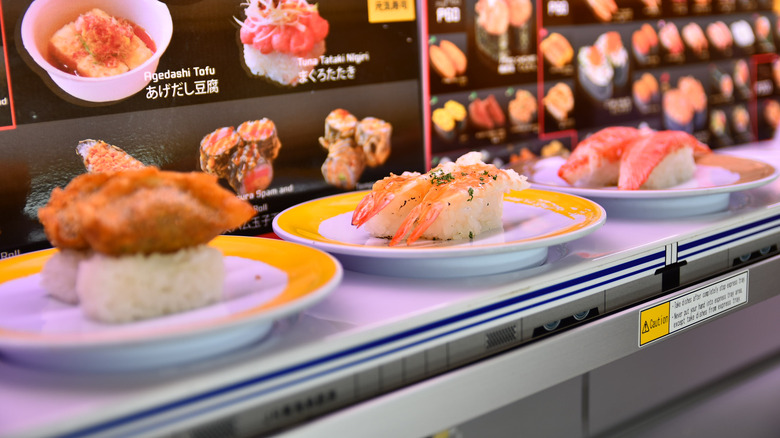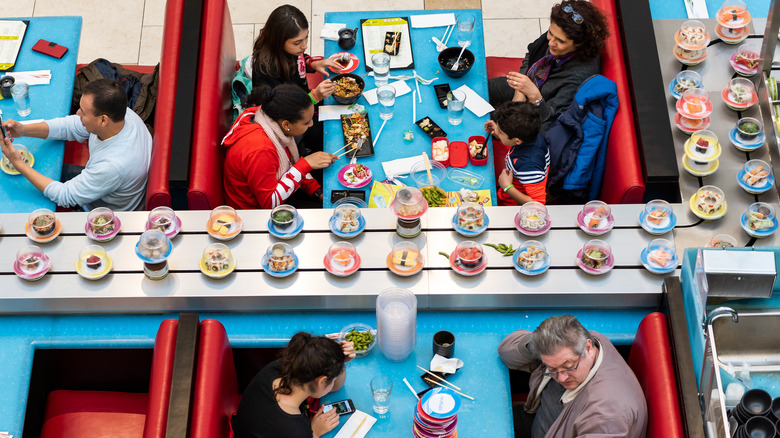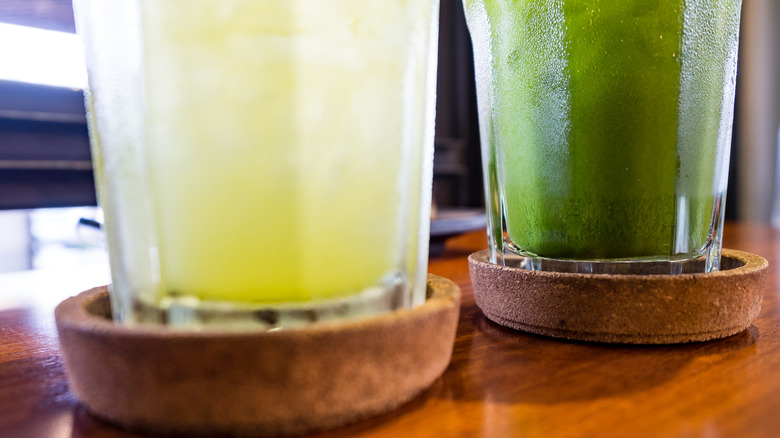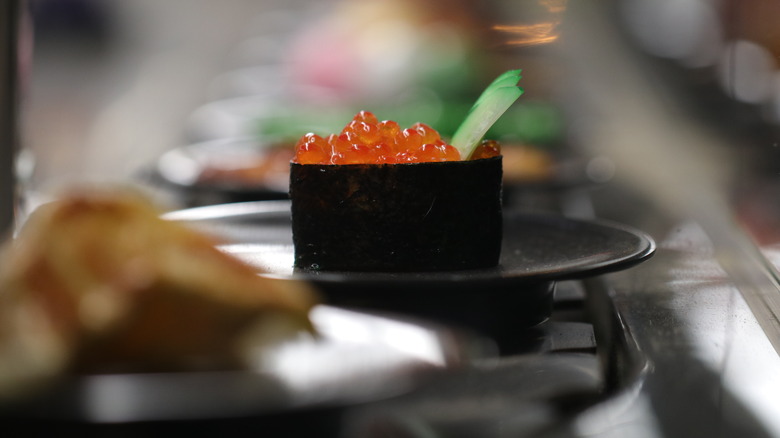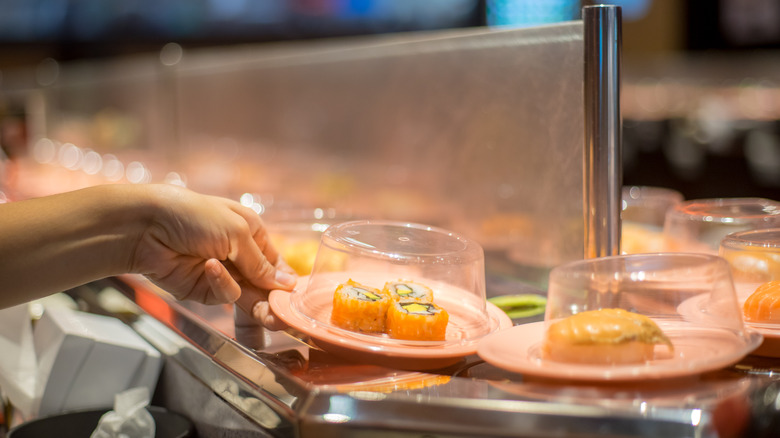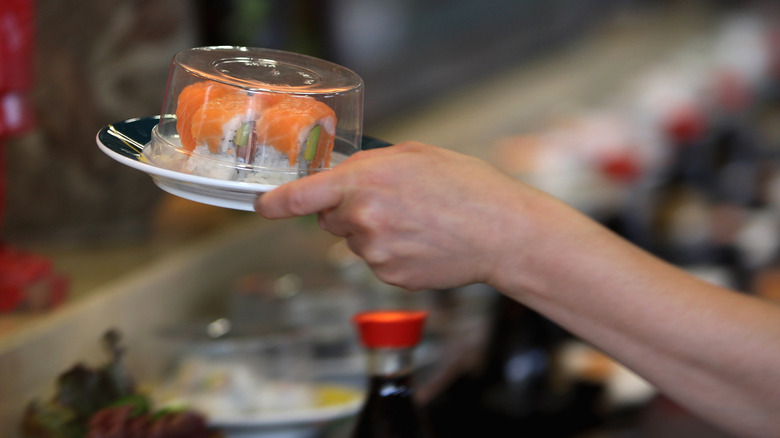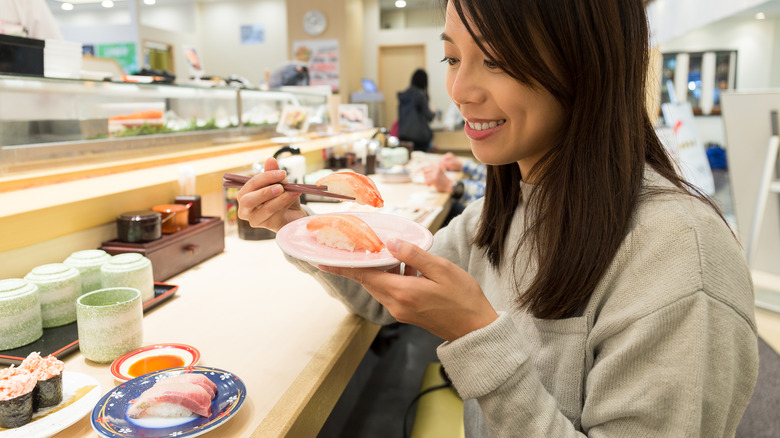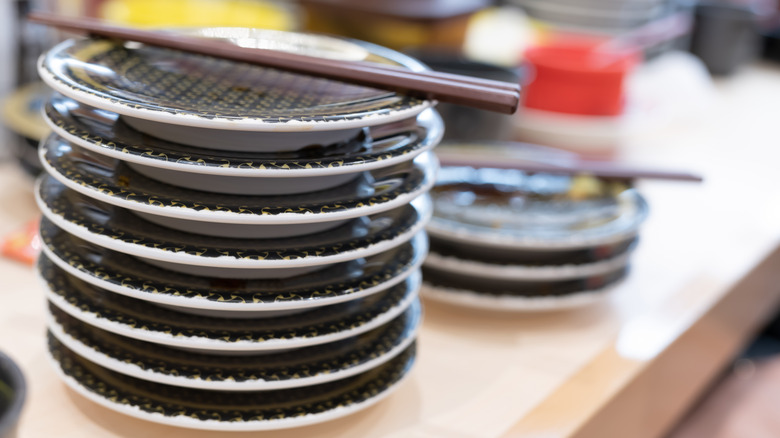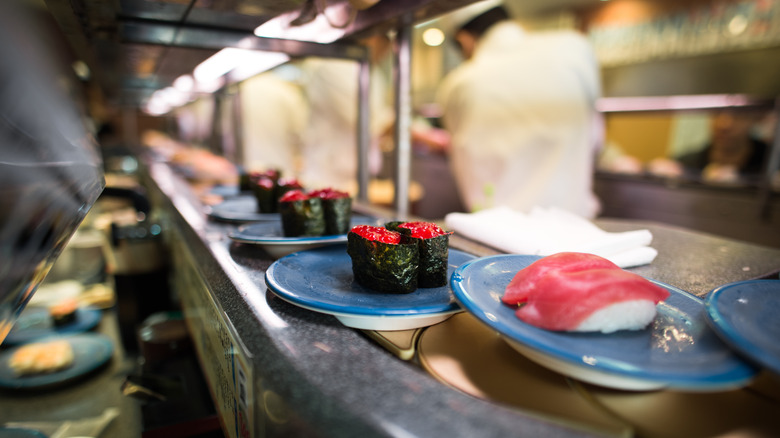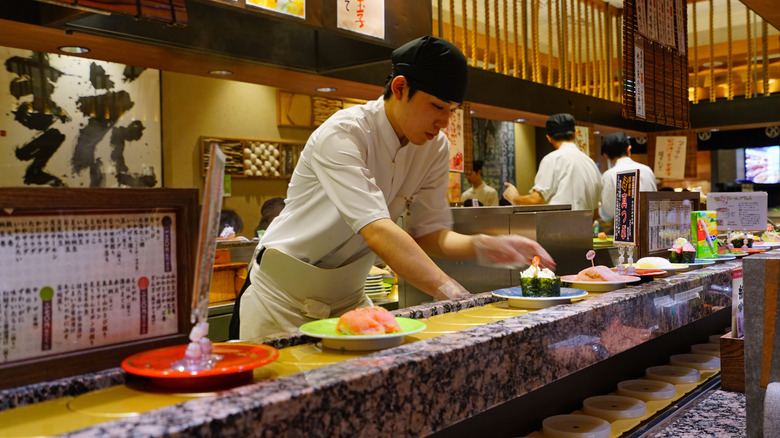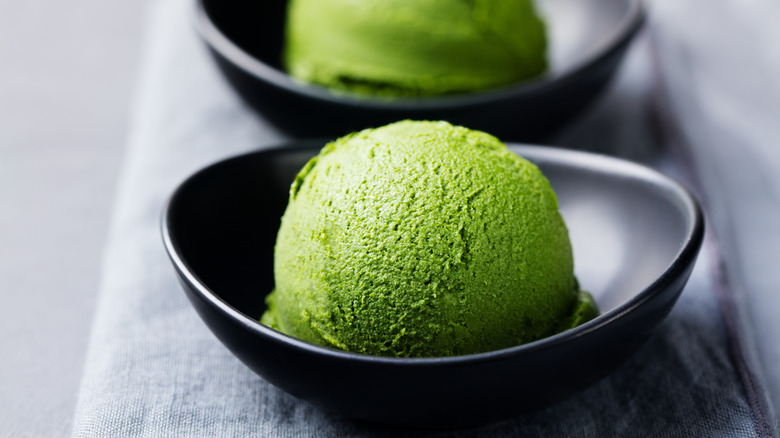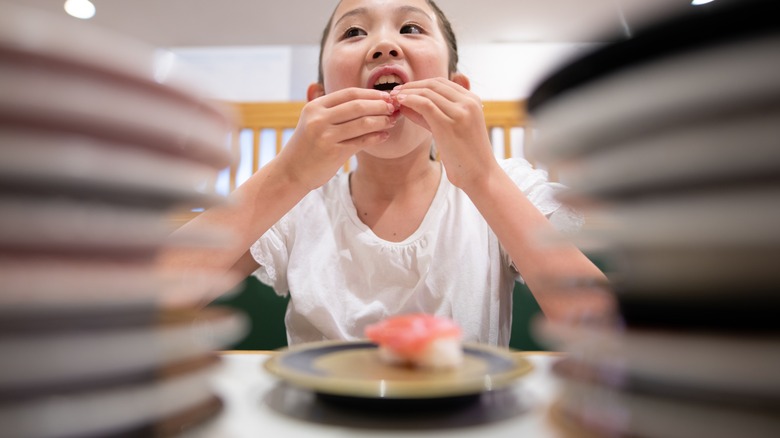The Ultimate Guide To Eating At A Conveyor Belt Sushi Restaurant
While American fast food can be wonderful to consume, there's something special about savoring the interactive enjoyment of a conveyor belt sushi restaurant. The dishes on these conveyor belts actually move right past you unless you grab them from the rotating sushi train or belt that they're served on. The first so-called kaiten-sushi restaurant opened in Japan in 1958. The Japanese restaurant owner who created the concept got the idea from beer bottles that were making the rounds on a conveyor belt at the Asahi factory.
Today, sushi lovers across the world love conveyor belt sushi restaurants, with brands like Sushi-Rama and Kura Sushi plating up numerous different kinds of sushi. However, understanding how to navigate these restaurants isn't always straightforward. It can feel frenetic to the uninitiated, even if the food is fabulous. But fret not: There are several different key tips that you can follow in order to make the most out of your restaurant experience.
Dine with someone else
Dining solo does have its merits. There's no one to share your favorite food with, and you can focus on eating rather than chatting. When you want a quick lunch, eating alone can be enjoyable and relaxing. Sushi conveyor belt restaurants look like they're the perfect place to eat if you're a party of one. After all, your chair is literally facing a train of rotating Japanese plates, which is perfect for an express bite. However, it's far better to find a dining companion for the experience as well.
A lot of sushi plates contain two pieces of sushi, and while they might not be huge, it's far better to share them. That way, you can sample a lot more of the menu without having to order excess or pay for everything yourself. If you've never been to this style of restaurant before, then you might like to take someone who has. It can be a little overwhelming to know how it all works at first and what the different dishes are. Eating with someone else at a kaiten-sushi joint promises a casual, quick, and often affordable meal, whether it's with a friend, a colleague, or a loved one.
Get your condiments ready
Before you chow down on some succulent sushi and whatever other delights come whizzing past you, make sure you get your condiments ready. When you sit down at the counter facing the conveyor belt, make sure you break apart your chopsticks so they're ready to use. You'll most likely have some little dishes in front of you, so add some soy sauce, which should be close at hand on your table.
Your server might bring you some pickled ginger, or there might be a big jar of it on the table. Add some of these pickled slithers to a dish or your plate. Wasabi is another condiment that is a must for many sushi and sashimi lovers. However, the wasabi might not be pure: It may consist of several different ingredients in addition to the horseradish. Most restaurants serve this fake wasabi, but it's still super popular and delicious.
If you're only served a little bit of wasabi, and it runs out, don't hesitate to ask for some more because raw fish just isn't the same without it. Remember, you most likely will not be charged for these condiments. But make sure you wipe your hands with the complimentary towel or tissue that these restaurants customarily offer. It's important to do this before you commence your sushi feast.
Check out which types of sushi are available first
When you're choosing dishes at a conventional restaurant, you probably read the menu before you decide, right? Okay, there are always going to be those eateries where you always order a favorite meal or selection of appetizers, sides, and entrées. You might want to do the same when you're at a kaiten-sushi place too. Of course, if you let a dish pass by on the conveyor belt, it may be grabbed by a diner, and it might not make its way around again. But the dishes are generally repeated, so letting a good few good ones go by gives you a good idea of which types of sushi are available.
You're likely to see lots of rolls, and if you're not sure whether to go for a California roll or a tuna roll, then check out our list of popular sushi rolls ranked worst to best first. Traditional sushi typically consists of raw fish served with a special type of rice that is sometimes rolled up, though not always. Nigiri is a rice mound with fish on top in which temaki is rolled nori seaweed with fish and rice inside. Gunken maki is rice wrapped in a band of seaweed, while sashimi is raw fish without rice. You can also order special dishes from the menu, so if you're craving miso soup and steamed egg, then you can order these separately.
Understand the portions and the prices of plates
If you order a sushi roll in a Japanese restaurant you'll get a set number of pieces. This usually makes up the whole roll. The best part of the sushi conveyor belt experience is that many of the plates going around will probably only have a couple of pieces per plate. This means you can try a greater variety of dishes without feeling too full. Of course, some plates will be bigger than others. Each plate is going to be small enough that you need several, so don't feel greedy if you soon have a stack of empty plates on the counter.
Different plate designs and colors may look eye-catching, but they're actually part of a price-coding system. Plates of a certain color will carry the same price tag, which may consist of lighter plates that are more affordable than darker ones. Likewise, a more ornate pattern on a plate of sushi may attract a higher price tag than a plain serving dish. Some of the sides on the belt, such as edamame and seaweed salad, may be cheaper. The portion sizes will be small enough that you may want to pick a few different plates to accompany your sushi.
Get some green tea before you eat
You don't have to drink green tea at a kaiten-sushi restaurant. However, in Japan, kaiten-sushi restaurants typically have a faucet of hot water on the counter and green tea powder so you can make your own tea. All you need to do is all a couple of spoonfuls of the powder to a mug, which should be nearby, and mix in the hot water. If you've never tried this hot drink before then give it a go. It's all part of the experience.
You don't have to drink hot green tea as it's popularly served in a long glass with lots of ice too. If you're planning on clearing the airways with a lot of wasabi, you might need something cool to take the edge off the heat. Soy sauce is also pretty salty, and it can make you thirsty as well, so before you start grabbing plates, make sure you're set up with a drink.
Of course, you can also order a cold beer, and you might want to try Japanese rice-based brews such as Asahi or Sapporo. Unfortunately, there may not be a beer tap at the counter. Sake is usually ordered either before or after a sushi meal unless you're ordering just sashimi. This is because it's rice-based, and so is sushi.
Choose the freshest plates
If you've been sitting at the counter long enough at your favorite sushi conveyor belt hotspot then you might have seen the same plate do several laps. While you might see certain types of sushi on the conveyor belt multiple times, that doesn't mean it's not freshly made. It might be so popular that it is being chosen and replaced at a fast rate. If this is the case, then it's going to be fresh. If you notice certain dishes aren't getting chosen and you're not sure how long they've been on the conveyor belt, just give them a miss.
You might want to check if any RFID tags are being used to monitor how long a sushi plate has been on the belt. These will ensure that dishes that haven't been chosen aren't going around for longer than recommended in terms of food hygiene. You could choose to sit close to the chef too so that you can see what's being prepared and ensure you only eat the freshest food. Looking at how busy the restaurant is should also give you some idea of the turnover of plates. And remember, you can order off the menu too. Some restaurants have screens you can order through, or you can ask your server for the relevant information.
Don't choose a plate someone else has touched
Rule 101 of eating at a sushi restaurant with a conveyor belt is that if you touch a plate then that dish is yours. Grabbing a plate and then taking a close look or lifting any cover on top and putting it back on the conveyor belt is an absolute no-no. If you see this happening with other customers then you might even want to mention it to a server. You definitely want to avoid touching any plates someone else has already grabbed. If you touch a plate then you're claiming it, then it needs to be immediately placed on the counter where you're sitting. And don't even think about putting it back on the belt.
While you might think this is common sense, a feature by engadget highlights that acts of so-called "sushi terrorism" do happen: This is when people tamper with plates on purpose and compromise the hygiene of other customers. The pandemic was the main reason that little cameras were added to sushi plate covers: Safeguards were introduced to stop multiple people from touching plates. This automation was geared toward making customers feel safe and preventing any kind of sushi sabotage.
Grab the plates from your chair
As the sushi train passes by, it's important to quickly jump on a grabbing a plate. If your dining companion says something to you and you look away, you may find that the sushi plate you had your eye on has already reached the next dining station. In other words, the person sitting along the counter is chowing down on it instead. Keep your eye on that belt and track your plate. It's not unlike the baggage claim belts at the airport: Once you spot your suitcase, get ready to pull it off and claim it.
For the belt to work well and for every diner to enjoy some fresh Japanese-style fast-food sushi, you have to stay put. Don't get up from your chair and start running along to catch a tuna roll you've missed further down the belt: Just wait for the next one. If you don't your desired sushi dish combing by quickly, then you can always speak to your server or put an order in. The sushi chef doesn't move around either, so all the plates are added at the same point. If you want first dibs then sit close to the spot where the chef puts the plates on the belt.
Understand the etiquette for eating sushi
So you've found a good seat, eyed up the sushi, and have all your condiments ready to go. You know how to grab your plates off the belt and recognize the cost of the different plates based on their color. Then, you can just relax and finally eat some incredible rolls and other Japanese delights. But it's important to ask yourself a quick question: Do you know the right way to eat sushi? While people are likely not expecting formal protocol at a sushi conveyor belt, understanding and following sushi etiquette is important for an ideal dining experience.
You can eat sushi with your fingers, but you should use chopsticks when eating sashimi. When you're dipping sushi into soy sauce, make sure you only dip the fish in, not the rice, as it will likely become soaked with too much of the liquid. When adding wasabi, only add it to the top of the fish, and don't mix it with your soy sauce. Note that wasabi is added to nigiri sushi under the fish. The ginger is usually eaten between sushi bites: Don't add it to your fish or rice or dip it in other condiments.
Stack your plates when they're empty
Counter space at sushi restaurants can be quite cramped. And even if you're at a restaurant that offers tables for groups you'll soon see the plates mount up. Don't expect them to be taken away by a server either, as they're a tally of what's been consumed. For this reason, it's important to stack the plates once you have eaten.
You might grab plates from the track, but that doesn't mean you put empty ones back on there. It's also not okay to bypass plates and simply grab some sushi directly off the belt with your chopsticks. Empty plates should not be going around the sushi train. While the plates may be ornately displayed and have leftovers on them, they should still be easily stackable. Having a ridiculously high stack of plates next to you is part of the fun of really enjoying the sushi train experience.
Order sushi if you don't see if on the belt
Once you've got to grips with grabbing dishes off the belt, eating sushi in the right way, and stacking your plates, you probably think that's all there is to know, but that's not quite true. Ordering sushi and not just relying on the sushi train will really elevate your experience, especially since the train has a lot of dishes, and you might keep missing the one you have your eye on because it seems to disappear before it gets to you. It's also a good idea to order sushi that's not on the belt.
Check out any boards or notices telling you about any specials of the day and find out which types of sushi are available to order off the menu. The sushi chef is going to be making a fairly wide selection of sushi, but don't feel shy about asking for a dish if you don't see it. The restaurant will be busy and quiet at different times, and if there's less of a demand for the kind of sushi you want, make sure the chef knows that you'd like to order a specific kind of sushi. If you do order sushi from the chef then it might come down the belt on its own carriage to identify it as an order.
Hot food should be ordered fresh
You might see dishes like shrimp tempura or karrage moving along the belt at a kaizen-sushi place. If you grab one as soon as it's made, then it's all well and good. However, if you've got the time and patience perhaps, then you might want to order any hot or cooked dishes fresh; that way, you get them at their best. Nobody likes soggy batter.
You'll no doubt find that there are a number of hot dishes that aren't added to the sushi belt. Most of the dishes on the conveyor belt are sushi plates with sashimi and the odd extra dish. Some diners want to focus on just what they can grab as it's passing by; however, it's a good idea to at least look at the menu, and if you have time and enough of an appetite, then you can order a couple of hot dishes so that you're making a real feast out of it. If you want to stick to fish, then grilled fish might be a good choice.
Leave room for dessert
Desert isn't as big a deal in a sushi conveyor belt restaurant as it might be in other styles of eateries. However, if you've got a sweet tooth or just want to cleanse your palate and your taste buds after lots of fatty sushi and sashimi, then leave room for a final course. You should see some fruit and dessert plates making headway around the belt. And by the time you get to this stage, you should know that the track is probably moving in a clockwise direction.
This line-up isn't all that's on offer. Remember, the focus is on sushi. Check out the menu, and you might see desserts such as green tea or matcha ice cream, which is super popular in Japan. Another Japanese sweet is mochi which is a sticky rice bite that's sometimes filled with red bean paste. There are a lot of interesting desserts to try, and there are just as unique and delicious as the savory dishes.
Keep track of the cost
It's easy to get carried away with conveyor belt sushi restaurants and end up eating a lot and spending a lot too. While conveyor belt sushi restaurants are more affordable than a lot of different sushi restaurants, lots of small plates can soon stack up quickly, quite literally. A good way to control your sushi spending is to set a budget before you go and make sure you're aware of the prices of different plates, which can vary wildly. Since these restaurants are ideal for a sharing experience, it's important to ensure that your dining buddy is on the same page regarding the budget.
If you order off of the menu, then be aware that certain dishes aren't on the belt because they're high-end choices. If you love fatty toro tuna (and few sushi-lovers could blame you), then you're likely not going for the lower-priced plates. A handy tip is to stack your plates according to colors and, therefore, prices, so you can easily add up how much you've spent before you reach for that last plate of salmon sashimi.
